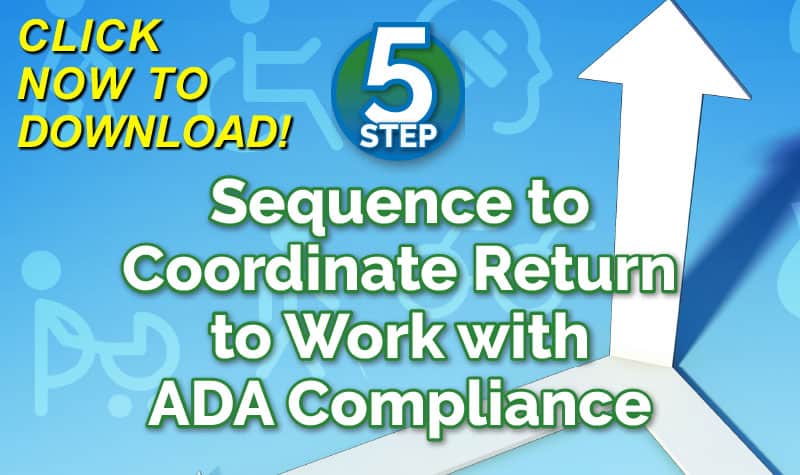
Aaron Konopasky, Senior Attorney Advisor, Equal Employment Opportunity Commission
Jennifer Christen, MD, President, Webility Corporation
Michael Stack, CPA / Risk Consultant, Amaxx Risk Solutions
This post is one of a series as a follow up to this webinar:
- ADA – Questions on Temporary and Permanent Restrictions
- ADA – Reasonable Accommodation And Workers Comp Questions Answered
- ADA – Ensure Interactive Process Compliance, And Other Questions Answered
- ADA – What Happens When An Employee Opposes Return To Work?
- ADA – If No Light Duty Is Available, Can The Employer Terminate Employment?
Click Link to Access Free PDF Download
“5-Step Sequence to Coordinate Return-to-Work with ADA Compliance”
A follow-training on How to Coordinate Return to Work with ADA Compliance initiated additional questions:
- ADA – If light duty cannot be accommodated, should FMLA run concurrently?
- ADA – Do All Work Comp Injuries Fall Under the Americans with Disabilities Act Amendments Act (ADAAA)?
- ADA – Is it against the law not to hire a person with a disability for a physical position?
If you allow 90 days of light duty and they do not seem to be increasing or progressing in treatment – can you place them back out of work until Full Duty (FD) or Maximum Medical Improvement (MMI)?
From a workers compensation management perspective, placing them back out of work at this point is not the recommended course of action as it is likely to spiral this employee and claim downward. You should be in discussions with the treating physician as to why they are not making progress. A nurse case manager might be helpful to better understand and assist the recovery.
From a medical perspective, 90 days is a sensible milestone. Most injuries have healed and are as good as they are going to get by that time — because most damaged tissue has repaired itself within 6 to 8 weeks. Those that haven’t may be turning into chronic conditions. However, there are some exceptions. The most obvious ones are workers who had conservative treatment for 6 or 8 weeks and then had surgery. An operation is like a re-injury and it resets the biological clock. One good way to identify the biological timeframe of recovery you are dealing with is to ask someone to look up the diagnosis in a resource like MDGuidelines or ODG to see what the typical durations of disability are for the worker’s particular condition. This will help you see whether it really is time to ask the doctor for more information.
There really are only three possibilities at this time for a worker’s comp case:
- The person has a good prognosis for full recovery back to baseline levels of function, but it’s happening more slowly than you hoped.
- You either need to wait for them to recover or find a reasonable accommodation that will let them do it, or pay them to sit home.
- The person is realistically never going to get back to baseline so it is time to look for a reasonable accommodation.
- If you and the worker can’t identify one, consider getting an expert in accommodations involved because they may see options you can’t. If there is no way to accommodate, consider your options and take the appropriate action. Don’t leave things hanging. If the person’s career at your company is over, don’t leave them hanging. Talk to them and express a desire to help them get on track towards a more realistic future outside your company.
- For some reason, it is still unclear what the eventual extent of functional recovery is going to be. If so, you need to talk to someone with expertise in these matters such as a nurse case manager or the treating physician in order to make an informed choice how to handle the situation.
For your responsibility under the ADA, does “light duty” mean reduced productivity requirements or elimination of essential functions? If so, then the ADA does not require the employer to continue the light duty assignment. However, before placing the individual back on leave, you must consider whether a reasonable accommodation would allow the person to return to full duty without imposing undue hardship on the employer. Would an assistive device help? An alternative schedule?
If the person is unable to return to full duty safely at this time, then they may be placed back out of work (although the employer could continue the light duty assignment if it wanted to, if it isn’t hurting the person or interfering with recovery). When the person should be brought back to full duty does not depend on Full Duty or Maximum Medical Improvement – it depends on when the person is able to go back to full duty with a reasonable accommodation (if one is necessary). So, if the person recovers enough that he or she can do the essential functions of the job with an alternative schedule, preferential shift assignment, assistive device, etc., then he/she can be place back to full time regardless whether he/she has reached MMI.
If the person does reach MMI and still can’t return to full duty, even with a reasonable accommodation, then the employer must consider reassignment to a vacant position, if one is available, as a reasonable accommodation. If there is no work that the person can do, even with a reasonable accommodation, then he/she may be terminated.
After how long would temporary accommodations provide presumptive evidence that permanent accommodations are reasonable?
By “accommodations,” do you mean the type of reasonable accommodation required by the ADA (for example, an alternative schedule, assistive device, telework, etc.), or do you mean something like light duty, with reduced productivity or elimination of essential functions?
If you mean an ADA accommodation, then there is no reason to presume one way or the other whether the accommodation will be permanent. You must provide the accommodation for as long as it’s needed, unless doing so becomes an undue hardship (causes significant difficulty or expense). This does not mean that you must ever create a new position, no matter how long the ADA accommodation is provided – ADA accommodations allow the person to perform the essential functions of the original position (but in a different way than usual – with an alternative schedule, adaptive equipment, etc.).
If you mean light duty or some other form of permission not to perform essential job functions, then the ADA doesn’t ever prevent you from taking it away. It’s possible that other laws, like WC laws, would have something to say about this though.
In general, workers’ compensation best practice dictates that transitional or light duty should last no more than 90 days. This, however, needs to be a flexible policy since some conditions do have natural healing times longer than that, so allowing an employee a longer time to recover might be considered a reasonable accommodation under the ADA.
If I have provided 90 days of accommodation, can that not be determined as an accommodation of a perceived disability, thus becoming reasonable on a permanent basis
By “accommodations,” do you mean the type of reasonable accommodation required by the ADA (for example, an alternative schedule, assistive device, telework, etc.), or do you mean something like light duty, with reduced productivity or elimination of essential functions?
If you mean an ADA accommodation, then there is no reason to presume one way or the other whether the accommodation will be permanent. You must provide the accommodation for as long as it’s needed, unless doing so becomes an undue hardship (causes significant difficulty or expense). This does not mean that you must ever create new position, no matter how long the ADA accommodation is provided – ADA accommodations allow the person to perform the essential functions of the original position (but in a different way than usual – with an alternative schedule, adaptive equipment, etc.).
Employees have a right to AN accommodation but not to a PARTICULAR one. Since circumstances and technologies can change over time, it would be illogical to say that the employer can’t ever change how a disability is being accommodated.
In Question 8 on your slides (Can the employer offer an employee an assignment at a different location such as a different division of the same company or at a charitable organization, if there are no suitable jobs at the original location?), are you talking about a permanent offer?
The question was referring to a temporary assignment, but there are some situations in which permanent reassignment may be required under the ADA.
If the individual is temporarily unable to return to full duty, even with an ADA reasonable accommodation (for example, an alternative schedule, assistive device, telework, etc.), then the ADA allows, but does not require, the employer to assign the person alternative duties that the individual can perform (including work at a local charity). As soon as the person is able to return to full duty at the original position, with a reasonable accommodation if one is necessary, then they must be returned to the original position. If the person will never be able to return to full time duty, even with a reasonable accommodation, then the employer should consider permanent reassignment as the “reasonable accommodation of last resort.” For reassignment to be required, the employer must have a vacant position available that the individual is qualified to perform. The ADA could never require an employer to permanently reassign someone to work for another business (e.g., a charity) at the employer’s expense.
What do we do as an employer when we are waiting for an IME report to come in? Do we use the treating Dr’s restrictions for permanent accommodation? What if the IME comes in and restrictions are completely different?
You are describing a situation in which the employer has been given limitations. The employer should engage in the interactive process with the employee to determine whether an ADA reasonable accommodation (for example, an alternative schedule, assistive device, telework, etc.) would allow the employee to do the essential functions of the job without causing pain, re-injury, etc., and without imposing undue hardship on the employer. The employer can ask follow-up questions of the treating doctor and the employee if it’s not clear whether return to full duty is possible. If a reasonable accommodation would allow the person to return, the person should be given the accommodation and returned to full-time duty. The employer would need to provide the accommodation for as long as it’s needed and does not impose undue hardship – there is no need to decide whether it will be permanent or temporary.
If the IME report comes in, the employer can reassess the need to provide an ADA accommodation, and if so which one, at that time. Again, engage in the interactive process with the doctors and the employee to figure out what the person can do with a reasonable accommodation. If there is a disagreement between the doctors or between the employee and the doctors, the employer will have to somehow decide who to believe. The employer could ask for further clarifying documentation to try to re solve the conflict.
With regards to temporary restrictions and the recommended 90 day limit, is there a risk to allowing transitional duty too long and thereby creating a permanent position inadvertently?
The recommended 90-day limit referred to some form of light duty or transitional work that allows the person to work at lowered productivity or that eliminates essential functions of the job. The ADA says nothing one way or the other about whether or how long this type of assignment is given (although, other laws might have something to say about that).
But be careful not to transfer the automatic 90-day limit over to ADA-required reasonable accommodations. An employer is required to provide ADA accommodations (for example, an alternative schedule, assistive device, telework, etc.) for as long as they are needed, unless doing so causes undue hardship (significant difficulty or expense). This does not mean that you must ever create new position, no matter how long the ADA accommodation is provided – ADA accommodations allow the person to perform the essential functions of the original position (but in a different way than usual – with an alternative schedule, adaptive equipment, etc.).
Author
Aaron Konopasky is a Senior Attorney Advisor in the ADA/GINA Policy Division at the U.S. Equal Employment Opportunity Commission (EEOC) headquarters in Washington, D.C. He assists the Commission in interpreting and applying the statutes it enforces, and participates in drafting regulations, policy guidance, and other publications.
Dr. Konopasky joined EEOC after receiving his J.D. from Stanford Law School. Prior to law school, he received his Ph.D. in philosophy from Princeton University, and served as an adjunct professor of philosophy at Rutgers University, Tulane University, and the University of New Orleans.
Author
Jennifer Christian, MD, MPH, FACOEM is a thought leader and advocate for improving medical outcomes and preventing needless work disability in workers’ compensation and disability benefits systems. She is board-certified in occupational medicine and earned both her medical and public health degrees from the University of Washington in Seattle. She chairs the Work Fitness & Disability Section of the American College of Occupational & Environmental Medicine (ACOEM). While practicing medicine in Alaska, she was chosen as Physician of the Year.
She is President of Webility Corporation, a management consulting and training company. Most recently, she developed Webility’s newest offering – the non-medical Maze-Masters program which provides educational and life coaching services directly to individuals who have gotten “lost in the system” to help them get their lives back on track.
Author:
Michael B. Stack, CPA, Principal, Amaxx Risk Solutions, Inc. He is an expert in employer communication systems and helps employers reduce their workers comp costs by 20% to 50%. He resides in the Boston area and works as a Qualified Loss Management Program provider working with high experience modification factor companies in the Massachusetts State Risk Pool. He is co-author of the #1 selling book on cost containment, Your Ultimate Guide To Mastering Workers Comp Costs www.reduceyourworkerscomp.com. Contact: mstack@reduceyourworkerscomp.com.









